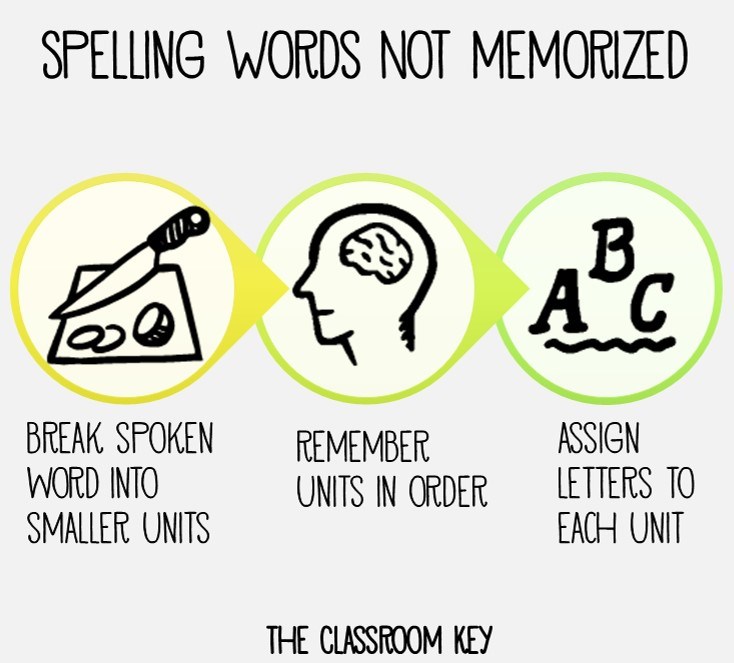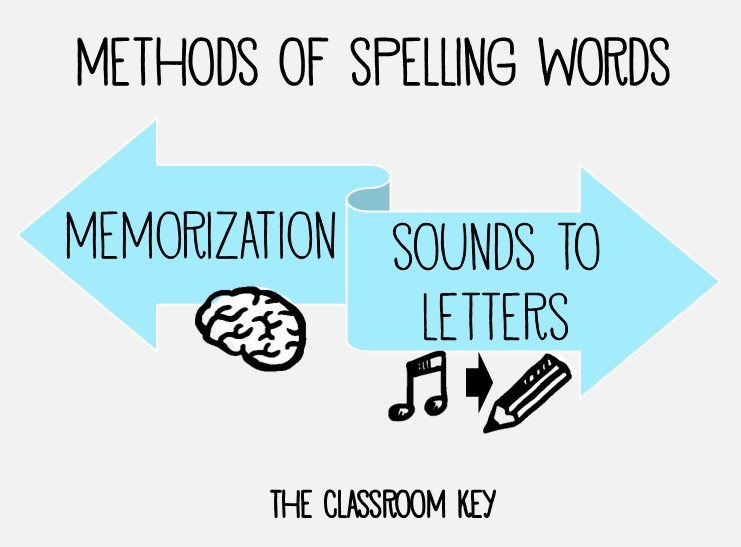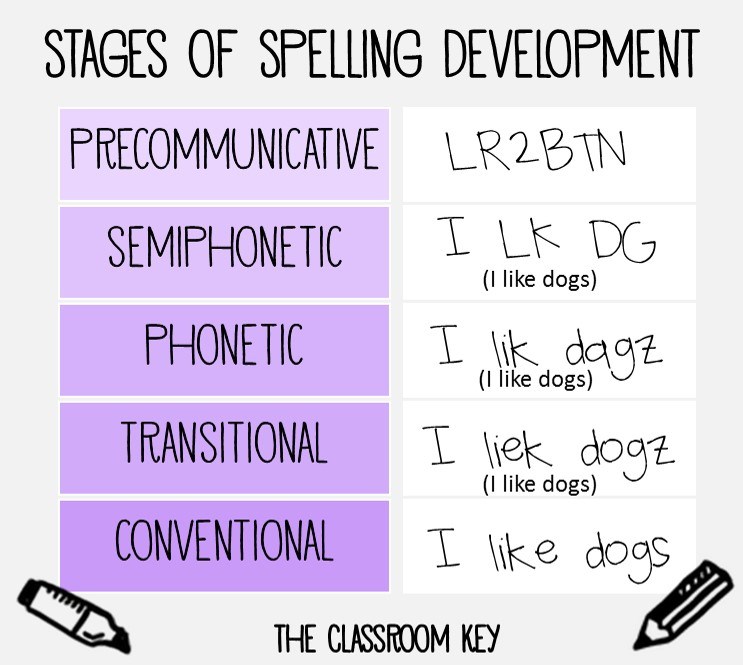Spelling Words NOT Memorized
Saturday, October 8, 2022 by Catherine Gilliland | Spelling

For students in the Phonetic and Transitional stages of spelling development (see my blog post from Sept. 26, 2022), there are a variety of strategies to practice the spelling words on an assigned list. While writing the words is extremely important, embracing a variety of practice methods engages the student's interest and expands their personal experiences with the word. Doing so with an enthusiastic attitude even further strengthens skill development. Try a few of these approaches with your child.
♥ J. Richard Gentry PhD, author, researcher, and literacy expert, encourages teachers to use A Five-Step Science-Based Spelling Pretest (For All Grades). Following these five steps not only improves spelling but contributes to a student's ability to become a fluent reader. On the Monday pretest, take the student through these five steps with each word: Hear It, Say It, Write It, Read It (and Self-Correct), Use It.
♥ Ask the student to identify any spelling patterns in their words that will help them to remember the spellings. Is there one consonant or vowel which is replaced with another to form a new word? For example, in the word CATCH the C can be replaced with the letters B, L, H, and others, creating completely new words with the same spelling pattern. In the word RAT, the A can be replaced with an O and U, forming new words with the same beginning and ending consonants. As patterns are identified, reinforce the associated spelling rules with the child. Include the various spelling rules and generalizations being used in their practice.
♥ A variation on the above is to write a consistent pattern in the words in one color while using a different color for the other letters.
♥ Play with the recitation of spelling rules and generalization with your child. Take turns reading or reciting the words or phrases of the rules. Play "20 Questions" or "I'm Thinking Of…" to guess which rule or generalization is being held in the mind. Playing games like this is great for highlighting the nuances contained in similar generalizations. Create and play a form of Pictionary with spelling rules and generalizations that need to be learned or reviewed.
♥ Ask the student to spell their spelling words orally, with letter tiles, pretzels, marshmallows and toothpicks, letters cut from a magazine, or other "tools" to stimulate their kinesthetic learning. If you use tiles, consider creating mini crosswords (as in the games Scrabble or Bananagrams).
♥ Use the computer keyboard to spell words over and over. Not only does the child reinforce spelling patterns, but they are also building muscle memory for the keyboard.
♥ Draw with sidewalk chalk the letters contained in the spelling words. Give the child a word to spell and let them hop from letter to letter to "spell" their word. Alternately, write one the letters on sheets of paper and spread them on the floor. Alternately, allow students to form the letters with their bodies as they say the letter names. Both methods slow down the spelling process and strengthen working memory, visual memory, gets the blood flowing to their brain through movement, and helps release some wiggles.
♥ Allow the child to use a whiteboard to spell their words. The slippery contact between the pen and board often makes the formation of letters easier for students. Added benefits include how easily mistakes can be wiped away and that exciting colors can be used.
♥ Sometimes words are simply "spelling demons". Using mnemonics to remember spellings is a great strategy for scaffolding students struggling with these words. For example, a PRINCIPAL is my PAL at school, while a PRINCIPLE is not. Even an anecdote for spelling a word as an acrostic can be helpful. For example, GEOGRAPHY can be remembered using George Edwards Old Grandpa Roasted A Pig Yesterday. Let the child create his own story to remind him of a tough word's correct spelling.
♥ Expose your child to their spelling words more than simply during spelling practice. "Hide" them around the house and let the child "seek" for them. Leave the list in a prominent location. Identify the words in books read aloud to your student.
♥ Play Hangman with current words. Include review spelling words to spice the game up a bit and include valuable review!
♥ Have fun practicing with your child in these fun and creative ways. Encourage, laugh, and celebrate. Embrace an attitude of delight in spelling. Model it for your student. Who knows, maybe they will learn to like spelling and you will strengthen your own spelling skills in the process.
Methods of Spelling Words
Saturday, October 8, 2022 by Catherine Gilliland | Spelling

For many, we learned to spell at an age so young, we remember little about the process itself. This can make it difficult to nurture the young spellers in our lives, or even give ourselves a hand when trying to remedy our own spelling deficiencies.
How do we learn to spell?
The methods are simple enough, however the process of growing skills in spelling requires patience and fortitude while we juggle our growing knowledge of the sounds we hear in words, with the symbols we use in our language to represent those sounds, along with knowledge of the smallest parts of words that can change word spellings and, therefore, their meanings, along with word origins and their impact upon spelling patterns. If that were not enough, the English language contains some sounds for which there are numerous symbols!
No wonder many children have proclaimed, "I hate spelling!" The process requires steadfast diligence, unwavering persistence, and endless patience. It stretches our working memory and our short term memory with uncomfortable tension. The reward, though, is a long term memory filled with an inventory of words with which one can effectively use to clearly communicate through written words.
Spelling is not completely memorization, although, when children are beginning to learn to read and spell, they do memorize what are commonly referred to as sight words. These words are made up of the commonly used words in children's literature and may or may not be easy to decode with phonics. When mastered, they free-up mental bandwidth to tackle harder or less frequent, albeit still important, words in their reading and spelling. These sight words are memorized through frequent exposure and practice.
Words that are not practical to memorize are best learned through a process of breaking the word into smaller sound parts, keeping the sound parts in order in one's working memory, then assigning correct symbols to communicate each of the sounds in order. By strengthening this process, students will increasingly be able to spell unfamiliar words they encounter in their lives with remarkable accuracy.
In young learners, the process of reading and spelling is most effective when carried out in tandem. Contrary to past opinion that learning to spell develops organically, research demonstrates the most effective method for learning to spell is to receive formal instruction, opportunities to practice, assessment, and feedback. Yes, reading does aid in components of learning to spell, but by itself will not produce a skilled speller. For those who can read but struggle to spell, they must return to the roots of identifying spelling patterns for the sounds in our language.
Stages of Spelling Development
Monday, September 26, 2022 by Catherine Gilliland | Spelling
 I am always amazed that I can observe one child who is learning to write and spell in one place and time and another child in another location and time and the two move through the same progression in the development of their skills! Like linguist Charles Read (1975), I have observed that even pre-reading children begin spelling words by inventing their own spellings based upon their current understanding of the sound contained in the word they are attempting to spell and the letter sounds about which they currently have knowledge. As their knowledge base expands children move gradually through the five stages of learning to spell.
I am always amazed that I can observe one child who is learning to write and spell in one place and time and another child in another location and time and the two move through the same progression in the development of their skills! Like linguist Charles Read (1975), I have observed that even pre-reading children begin spelling words by inventing their own spellings based upon their current understanding of the sound contained in the word they are attempting to spell and the letter sounds about which they currently have knowledge. As their knowledge base expands children move gradually through the five stages of learning to spell.
Charles Read concluded that, by and large, "learning to spell is not a matter of memorizing words, but a developmental process that culminates in a much greater understanding of English spelling than simple relationships between speech sounds and their graphic representations."
J. Richard Gentry (1982), using Read's research as a foundation, describes five stages: precommunicative, semiphonetic, phonetic, transitional, and correct.
-
Precommunicative stage
The child uses symbols from the alphabet but shows no knowledge of letter-sound correspondences. The child may also lack knowledge of the entire alphabet, the distinction between upper- and lower-case letters, and the left-to-right direction of English orthography. -
Semiphonetic stage
The child begins to understand letter-sound correspondence and that sounds are assigned to letters. At this stage, the child often employs rudimentary logic, using single letters, for example, to represent words, sounds, and syllables (e.g., U for you). -
Phonetic stage
The child uses a letter or group of letters to represent every speech sound that they hear in a word. Although some of their choices do not conform to conventional English spelling, they are systematic and easily understood. Examples are KOM for come and EN for in. -
Transitional stage
The speller begins to assimilate the conventional alternative for representing sounds, moving from a dependence on phonology (sound) for representing words to a reliance on visual representation and an understanding of the structure of words. Some examples are EGUL for eagle and HIGHEKED for hiked. -
Correct stage [or Conventional]
The speller knows the English orthographic system and its basic rules. The correct speller fundamentally understands how to deal with such things as prefixes and suffixes, silent consonants, alternative spellings, and irregular spellings. A large number of learned words are accumulated, and the speller recognizes incorrect forms. The child's generalizations about spelling and knowledge of exceptions are usually correct.
Gentry, J. Richard. "An Analysis of Developmental Spelling in GNYS AT WRK." An Analysis of Developmental Spelling in "GNYS AT WRK" on JSTOR, 1982.
Read, Charles. CHILDREN'S CATEGORIZATION OF SPEECH SOUNDS IN ENGLISH. Urbana, IL: ed112426.tif.pdf, 1975.
For more information see Reading Rockets "Invented Spelling and Spelling Development".
Soft Skills: Family Night
Friday, September 16, 2022 by Catherine Gilliland | Soft Skills
How Family Nights Strengthen Soft Skills
Family nights were something that my kids looked forward to each week! As we reflected on our experiences during family night, we were able to identify many soft skills that were developed during this precious family time!
As we planned these nights, we were careful to plan experiences that were special. What made experiences special for our family? Ones that were uncommon for our children, that every family member could enjoy in their own way, that strengthened our family team, that fostered good memories, and ones that enhanced interpersonal relational and communication skills. Creating experiences at times presented challenges because there was a 15-year span of ages between the oldest and youngest children in our family, the kids had a variety of interests, and there were both boys and girls.
As parents, we kept our ears and eyes open for ideas that we could implement directly or use as a springboard for our own version. Sometimes we used the internet to search, sometimes the title of a book or content of a speaker would spark an idea for us. The key for us was to keep our family vision goals in mind and be creative!
To spark your own creativity in creating special family night experiences for your crew, you might consider any of the following: play team-building games; participate in a ropes course; go ziplining; take a nature scavenger hunt; attend a movie or play at a theater; learn backyard games such as kickball, softball, bocce ball, croquet, or badminton; volunteer for a special cause; decorate Christmas cookies; create balloon sculptures; play silly "youth group" games; take a walk at a special place or walk in a dark location to gaze at the stars; attend a special event; play in the snow together (stage an epic snowball "fight",building a snow fort; create a cluster of snowmen, snow ladies, and pets to represent your family); decorate for a holiday together (let kids create some of the decorations); stage a family impromptu speech night with easy, fun topics.
Remember to incorporate into your family night plenty of laughter, affirmations, loving embraces, and document the time by taking plenty of spontaneous pictures! You may even want to consider ending each family night with a dedicated time of praise from one family member to another. Be ready to witness your family relationships grow and your children become increasingly equipped for successfully navigating life beyond the home!


